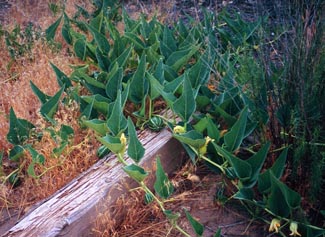Coyote Melon Gourd

Common Name(s):
Coyote Melon Gourd
Coyote Melon
Coyote Gourd
Scientific Name:
Cucurbita palmata S. Wats.
Scientific Name Synonyms:
Cucurbita californica Torr. ex S. Wats.
Symbol:
CUPA
Description:
Life Span: Perennial
Origin: Native
Growth Characteristics: Coyote melon gourd has similar growth habits to those of cucumbers and pumpkins, including large leaves and spreading vines.
Flowers/Inflorescence: Large yellow flowers that are bell shaped and occur solitarily in the leaf axils.
Fruits/Seeds: The gourd is smooth, many seeded, and striped, and has a hard rind. The rind becomes very thin with maturity. The gourd is very bitter.
Leaves: Leaves are dark green and arrowhead shaped, with white, fingerlike veins.
Stems: Stems are thick with short, coiled tendrils.
Roots: Coyote Melon Gourd has an immense taproot that may extend several feet into the ground. The taproot often sends out many lateral, sprouting branches.
Ecological Adaptions:
Coyote Melon Gourd grows in full sun or partial shade. In Utah, it is only found in Washington County.
Soils: Dry, sandy places.
Associated Species: Creosote bush, blackbrush
Uses and Management:
The melons are not edible, but were used as soap by Native Americans. Native Americans also ground the seed and used it for food. Dried gourds were used as rattles in dances.
The vine can become invasive.

